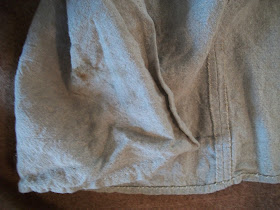Based on some feedback from the article I wanted to post some examples of my interpretations of the primary sources in the previous post. Washington was a proponent of the humble hunting shirt throughout the war, which hearkened back to his days as Colonel of the First Virginia where he had his men clothed in "
Indian Walking Dress" (presumably trade shirt, leggings, breechclout, and matchcoat). The photo above depicts my interpretation of the shirt Washington was recommending in 1776, based off the evidence of Virginia orderly books and deserter notices. Split front, square cut, and sparsely fringed.
 |
| Captain Samuel Blodget in Rifle Dress, ca. 1786, John Trumbull [2] |
The above Trumbull painting of Captain Blodget (ten years' service in New Hampshire Militia) closely follows the dress recommended by Washington. Trumbull, you will recall, had also painted Morgan in similar dress in "The Surrender of Burgoyne" a later work of the early 19th c, and was present during the campaigns of 1775-6.
Even though the only extant shirts of the previous are EXTENSIVELY fringed, I believe, based on the time it takes to make the fringe for the collar (and I have made several), that the shirts would have been lightly fringed (in accordance with the information provided in the 2d and 6th Virginia orderly books of 1775, 76).
 |
| Collar detail, button closure, and neck gusset. |
 |
| Button tab |
On extant shirts, you cannot see the collar closure, so the above photo is conjecture-my best guess. It is the same tow-linen as the shirt fashioned into a tape by means of a straight stitch. It is then fashioned into a loop and sewn to the inside of the shirt, behind the point that the cape joins the body of the shirt. A simple shell button is used as well. I have also seen a loop of linen or hemp cord used in place of the cloth loop at the collar as well as the cuffs on reproduction shirts.
 |
| Arm gusset. |
 |
| Cuff, button hole, and shell button. |
A brief word on hand stitching and button-holes. It does take practice, it does take time, but in my humble opinion...
 |
| Detail of finished hem and seam. |
...its worth it-both inside and out.
The following photos are of my son's early-war musician's hunting shirt. This would have been worn by the Musick of the First Virginia until such time as regimentals were procured (quartermasters receipts suggest as early as 1777).
 |
| Drummer's Shirt and Accoutrements, circa 1775-76 |
This placket front shirt has broadcloth added to the collar and cuffs, in this case to identify the wearer as a musician. The 1st and the 6th Virginia both may have added cloth. The 1st to designate companies (no facing, Green, Blue, or Red) and the 6th Red, with white or other colors to designate rank on the cuffs [3]. My humble preference is to go without the colored tabs as I can only find three references from late 1775-76 that suggest this: A receipt from the Virginia Public Store, the Dixon and Hunter deserter advertisements, and the 6th Virga Orderly book. I think the plain shirt is simply more generic.
 |
| Cape with company/section color |
 |
| Placket Front |
Note on this shirt that the front opening terminates at a placket with reinforcement straight stitched to the reverse. This vice the split front goes back to the argument of the definition of "shirt".
 |
| Cuff with facing |
The following photographs are of a simple, square cut body-shirt. We do know that multiple shirts were worn for warmth or to cover the small clothes while working. This is what I believe Washington spoke of when he referred to "
Indian Walking Dress", what Patrick Henry's "
Shirtmen" probably wore on their march from Hanover Court House during the 1775 Gunpowder Affair-again merely conjecture, and quite possible also the Culpeper Minute Battalion "
dyed the colour of leaves" [4].
 |
| A simple body shirt and hunting accoutrements. |
 |
| Rectangular gusseted collar, button-hole closure. |
 |
| Horn button, gusseted shirt tails, and finished hems. |
Washington is absolutely correct about this being a very practical form of dress for all seasons. I have worn this as an overshirt with a wool sleeved weskit, a wool weskit, and body-shirt underneath. Wool breeches, leather leggings, and blanket-lined moccasins on my feet, monmouth cap on my head. My first attempt was in California's San Gorgonio Mountains in February, with snow on the ground.
It was cold, but...tolerable, both on the move and at night with the addition of a thick wool matchcoat (blanket).
-Cincinnatus
[1]
General Orders, Washington Papers.
[2] Captain Samuel Blodget in Rifle Dress, ca. 1786, John Trumbull, (British American, 1756 - 1843), oil on canvas, 21 3/16 x 17 1/8 in. (53.8 x 43.5 cm.). The J. Harwood and Louise B. Cochrane Fund for American Art 2001.2
http://www.bing.com/images/search?q=Trumbull+Paintings&view=detail&id=DB3C1D7872CB6D97146152C50A86E3130BF7947E&first=176
[3]
Lewis, Andrew. The orderly book of that portion of the American army stationed at or near Williamsburg, Va., under the command of General Andrew Lewis, from March 18th, 1776, to August 28th, 1776, Yale Press 1860., pp13-14, http://archive.org/details/39002055099973.med.yale.edu accessed 24 Feb12.
[4]
Travers, Raleigh, Ed., Journal of Captain Slaughter, as quoted in Notes on Culpeper County, Virginia; "Embracing a Revised and Enlarged Edition of Dr. Philip Slaughter's History of Saint Mark's Parish". Compiled and Published, Culpeper Va, 13.














No comments:
Post a Comment